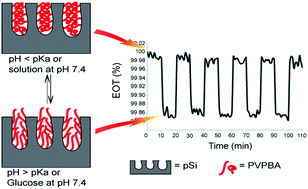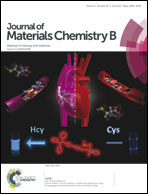A photonic glucose biosensor for chronic wound prognostics†
Abstract
The ability to monitor glucose levels in chronic wound fluid of diabetic patients is a promising theranostic approach in chronic wound healing. Phenylboronic acid polymers are glucose- and pH-responsive materials. In the presence of glucose, these polymers reversibly form cyclic boronate esters, changing the properties of the polymer and forming the basis of glucose sensing. In this report, poly(4-vinylphenylboronic acid) (PVPBA) was covalently grafted to the pores of porous silicon (pSi) films (pSi-PVPBA). Polymer switching in response to changing pH and glucose concentration was monitored by means of interferometric reflectance spectroscopy (IRS). We observed that a shift of the boronic acid equilibrium between the neutral and anionic form in the polymer translated into refractive index changes that could be detected as a variation of the effective optical thickness (EOT) of the pSi-PVPBA film. The pSi/polymer composite was further investigated as a platform for the detection of glucose. Using this sensing platform, we were able to detect glucose in a buffer solution as low as 0.15 mM and also in a wound fluid sample without encountering interferences.


 Please wait while we load your content...
Please wait while we load your content...